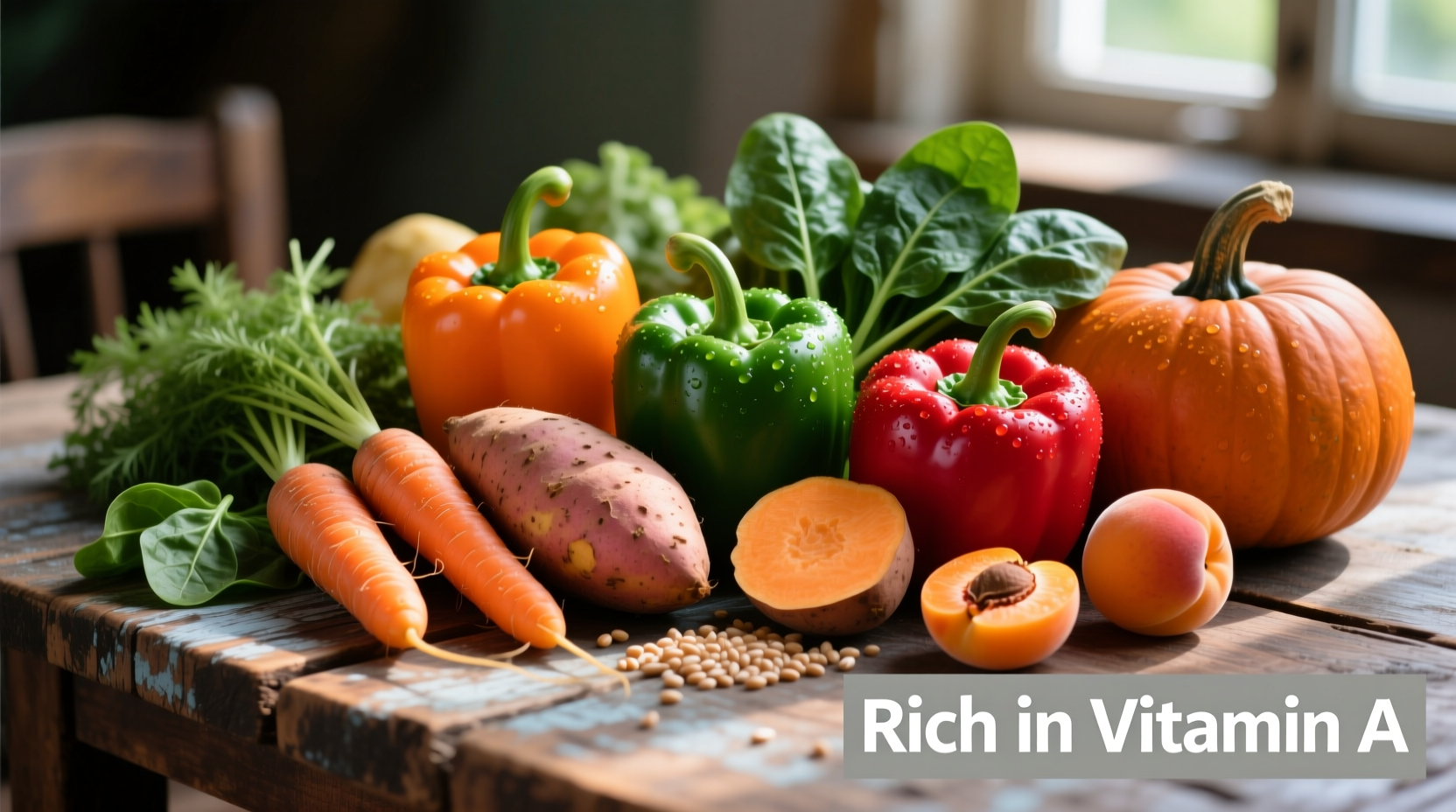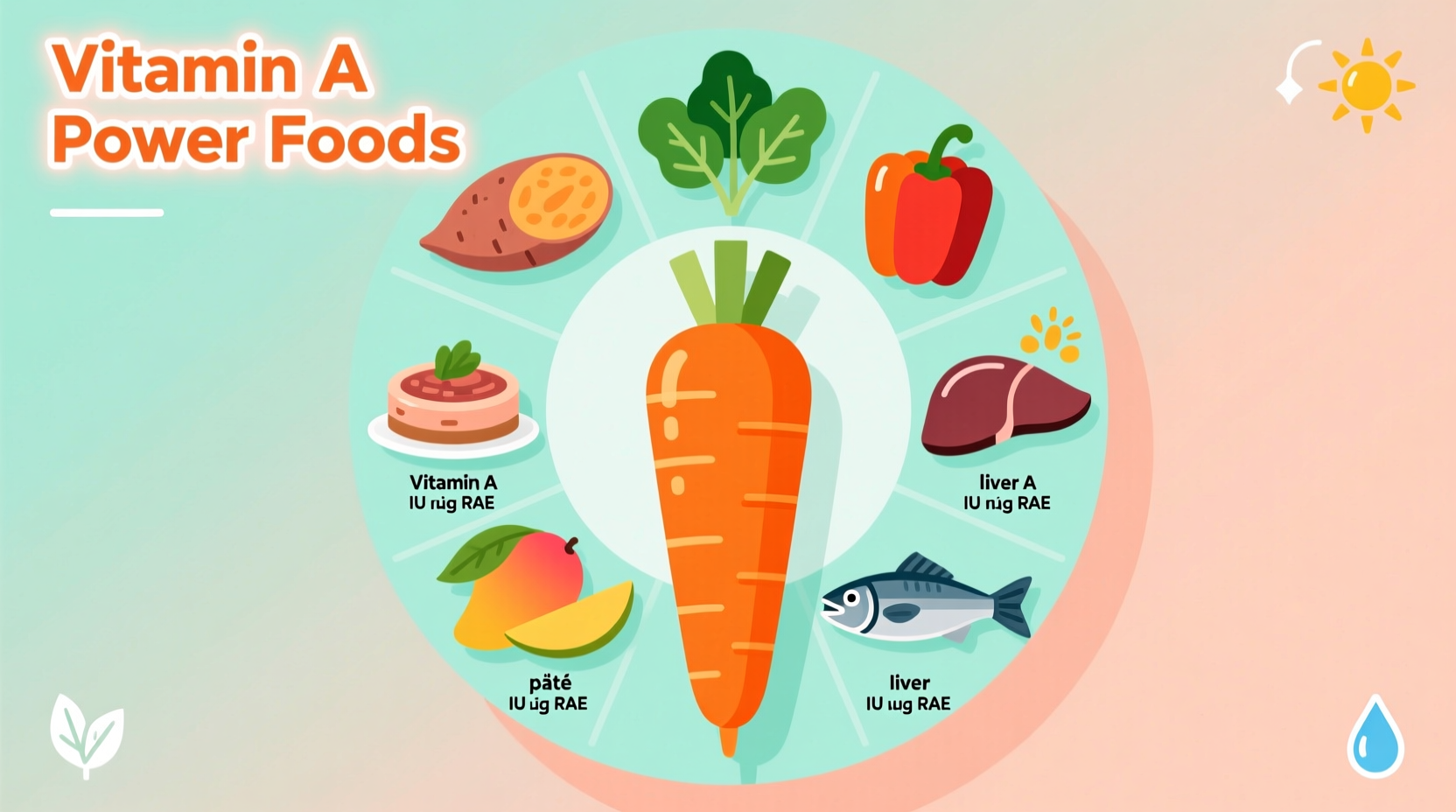Vitamin A is essential for vision, immune function, and skin health. The top food sources include liver (3,461 mcg per 3 oz), sweet potatoes (1,403 mcg per medium potato), carrots (835 mcg per half cup cooked), spinach (573 mcg per half cup cooked), and cantaloupe (270 mcg per cup). Animal sources provide preformed vitamin A (retinol), while plant sources offer beta-carotene that your body converts to vitamin A.
Discover exactly which foods deliver optimal vitamin A intake for your specific health goals. Whether you're addressing dietary deficiencies, planning balanced meals, or optimizing your nutrition for eye health and immune support, this guide provides science-backed food recommendations with precise measurements you can trust.
Why Vitamin A Matters for Your Health
Vitamin A isn't just about good vision—it's crucial for maintaining healthy skin, supporting immune function, and ensuring proper cell growth throughout your body. The National Institutes of Health recommends 900 mcg RAE (Retinol Activity Equivalents) daily for adult men and 700 mcg for women. Pregnant and breastfeeding women require higher amounts to support fetal development and infant nutrition.
Understanding the two primary forms is essential: preformed vitamin A (retinol) found in animal products that your body uses directly, and provitamin A carotenoids (like beta-carotene) from plant sources that your body converts as needed. This conversion process provides a natural safety mechanism against excessive intake from plant sources.
Vitamin A Powerhouses: Animal and Plant Sources Compared
Animal-based sources deliver vitamin A in its most bioavailable form, while plant sources provide carotenoids that your body converts to active vitamin A. Both types play important roles in a balanced diet, but their absorption rates and health impacts differ significantly.
| Food Source | Serving Size | Vitamin A (mcg RAE) | Percentage of Daily Value |
|---|---|---|---|
| Liver (beef) | 3 ounces | 3,461 | 385% |
| Sweet potato | 1 medium | 1,403 | 156% |
| Carrots | ½ cup cooked | 835 | 93% |
| Spinach | ½ cup cooked | 573 | 64% |
| Cantaloupe | 1 cup | 270 | 30% |
| Egg | 1 large | 75 | 8% |
Data sourced from USDA FoodData Central (2023) shows significant variations in vitamin A content across different food categories. Animal sources generally provide more concentrated vitamin A, but plant sources offer additional phytonutrients and fiber without the risk of vitamin A toxicity associated with excessive animal-source consumption.
Maximizing Vitamin A Absorption from Your Foods
Simply eating vitamin A-rich foods isn't enough—you need to optimize absorption. Vitamin A is fat-soluble, meaning it requires dietary fat for proper absorption. Pairing carrots with olive oil or adding avocado to your spinach salad can increase vitamin A uptake by up to 150%, according to research published in the American Journal of Clinical Nutrition.
Cooking techniques matter too. Lightly steaming carrots increases beta-carotene availability by breaking down cell walls, while overcooking destroys valuable nutrients. For maximum benefit, cook vegetables until just tender-crisp rather than soft. Raw spinach contains valuable nutrients, but cooking concentrates the volume, allowing you to consume more vitamin A in a single serving.

Practical Meal Planning with Vitamin A Foods
Integrating vitamin A-rich foods into your daily meals doesn't require dramatic changes. Start your day with scrambled eggs (75 mcg per egg) and sautéed spinach (573 mcg per ½ cup cooked). For lunch, prepare a sweet potato and black bean bowl with avocado dressing. Dinner could feature baked salmon (53 mcg per 3 oz) with roasted carrots and kale.
Budget-conscious eaters will appreciate that many vitamin A powerhouses are affordable staples. Sweet potatoes cost approximately $0.80 per pound and provide over 100% of your daily vitamin A needs in one medium potato. Carrots and frozen spinach offer exceptional nutritional value for minimal cost.
Seasonal availability affects your options: summer brings cantaloupe and bell peppers, while winter offers squash and dark leafy greens. Frozen spinach and carrots maintain their vitamin A content year-round, making them reliable pantry staples.
Special Considerations for Different Life Stages
Vitamin A needs change throughout life. Infants receive adequate vitamin A through breast milk, but introducing pureed sweet potatoes around six months provides important additional sources. Children need vitamin A for growth and development, with recommended intakes ranging from 300-600 mcg depending on age.
Pregnant women require careful balance—while vitamin A is crucial for fetal development, excessive preformed vitamin A from supplements or liver can cause birth defects. The World Health Organization recommends obtaining vitamin A primarily from plant sources during pregnancy. Breastfeeding mothers need increased intake to support both their health and their baby's development.
Older adults may need to pay special attention to vitamin A intake as absorption efficiency decreases with age. However, they should avoid high-dose supplements due to potential interactions with medications and increased risk of bone fractures with excessive vitamin A.
Frequently Asked Questions
Can you get too much vitamin A from food?
Yes, excessive vitamin A intake is possible primarily from animal sources and supplements. Consuming more than 3,000 mcg RAE daily from preformed vitamin A over time can cause toxicity symptoms including dizziness, nausea, and hair loss. Plant-based beta-carotene doesn't cause toxicity as your body regulates conversion to active vitamin A.
Which vitamin A foods are best for eye health?
Foods rich in both vitamin A and lutein provide optimal eye health benefits. Sweet potatoes, carrots, spinach, and kale offer the best combination. The Age-Related Eye Disease Study found that diets high in these foods reduce the risk of macular degeneration by up to 25%.
How can vegetarians ensure adequate vitamin A intake?
Vegetarians should focus on orange and dark green vegetables. One cup of cooked spinach provides 64% of daily needs, while a medium sweet potato delivers 156%. Consuming these with healthy fats like avocado or olive oil significantly boosts absorption. Including a variety of colorful vegetables throughout the day ensures adequate intake without animal products.
Does cooking destroy vitamin A in foods?
Cooking affects vitamin A differently depending on the food. Light cooking actually increases beta-carotene availability in carrots and sweet potatoes by breaking down cell walls. However, prolonged high-heat cooking can degrade vitamin A. Steaming or quick sautéing preserves more nutrients than boiling. Fat-soluble vitamin A is more stable during cooking than water-soluble vitamins.











 浙公网安备
33010002000092号
浙公网安备
33010002000092号 浙B2-20120091-4
浙B2-20120091-4